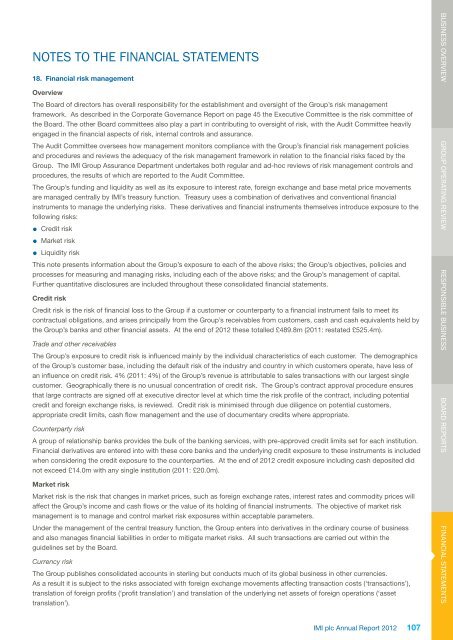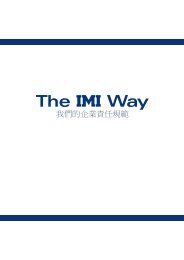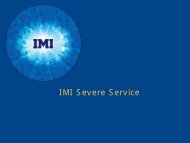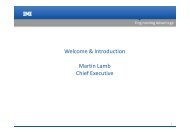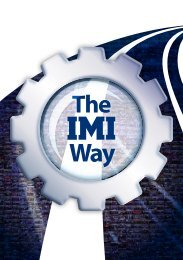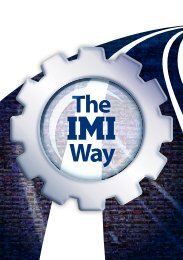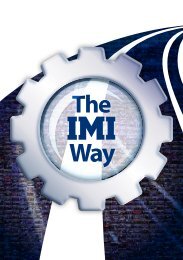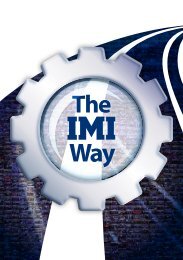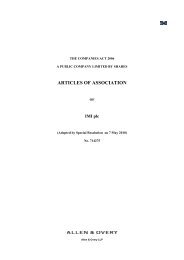IMI plc annual report 2012
IMI plc annual report 2012
IMI plc annual report 2012
Create successful ePaper yourself
Turn your PDF publications into a flip-book with our unique Google optimized e-Paper software.
NOTES TO THE FINANCIAL STATEMENTS18. Financial risk managementOverviewThe Board of directors has overall responsibility for the establishment and oversight of the Group’s risk managementframework. As described in the Corporate Governance Report on page 45 the Executive Committee is the risk committee ofthe Board. The other Board committees also play a part in contributing to oversight of risk, with the Audit Committee heavilyengaged in the financial aspects of risk, internal controls and assurance.The Audit Committee oversees how management monitors compliance with the Group’s financial risk management policiesand procedures and reviews the adequacy of the risk management framework in relation to the financial risks faced by theGroup. The <strong>IMI</strong> Group Assurance Department undertakes both regular and ad-hoc reviews of risk management controls andprocedures, the results of which are <strong>report</strong>ed to the Audit Committee.The Group’s funding and liquidity as well as its exposure to interest rate, foreign exchange and base metal price movementsare managed centrally by <strong>IMI</strong>’s treasury function. Treasury uses a combination of derivatives and conventional financialinstruments to manage the underlying risks. These derivatives and financial instruments themselves introduce exposure to thefollowing risks:• Credit risk• Market risk• Liquidity riskThis note presents information about the Group’s exposure to each of the above risks; the Group’s objectives, policies andprocesses for measuring and managing risks, including each of the above risks; and the Group’s management of capital.Further quantitative disclosures are included throughout these consolidated financial statements.Credit riskCredit risk is the risk of financial loss to the Group if a customer or counterparty to a financial instrument fails to meet itscontractual obligations, and arises principally from the Group’s receivables from customers, cash and cash equivalents held bythe Group’s banks and other financial assets. At the end of <strong>2012</strong> these totalled £489.8m (2011: restated £525.4m).Trade and other receivablesThe Group’s exposure to credit risk is influenced mainly by the individual characteristics of each customer. The demographicsof the Group’s customer base, including the default risk of the industry and country in which customers operate, have less ofan influence on credit risk. 4% (2011: 4%) of the Group’s revenue is attributable to sales transactions with our largest singlecustomer. Geographically there is no unusual concentration of credit risk. The Group’s contract approval procedure ensuresthat large contracts are signed off at executive director level at which time the risk profile of the contract, including potentialcredit and foreign exchange risks, is reviewed. Credit risk is minimised through due diligence on potential customers,appropriate credit limits, cash flow management and the use of documentary credits where appropriate.Counterparty riskA group of relationship banks provides the bulk of the banking services, with pre-approved credit limits set for each institution.Financial derivatives are entered into with these core banks and the underlying credit exposure to these instruments is includedwhen considering the credit exposure to the counterparties. At the end of <strong>2012</strong> credit exposure including cash deposited didnot exceed £14.0m with any single institution (2011: £20.0m).Market riskMarket risk is the risk that changes in market prices, such as foreign exchange rates, interest rates and commodity prices willaffect the Group’s income and cash flows or the value of its holding of financial instruments. The objective of market riskmanagement is to manage and control market risk exposures within acceptable parameters.Under the management of the central treasury function, the Group enters into derivatives in the ordinary course of businessand also manages financial liabilities in order to mitigate market risks. All such transactions are carried out within theguidelines set by the Board.Currency riskThe Group publishes consolidated accounts in sterling but conducts much of its global business in other currencies.As a result it is subject to the risks associated with foreign exchange movements affecting transaction costs (‘transactions’),translation of foreign profits (‘profit translation’) and translation of the underlying net assets of foreign operations (‘assettranslation’).BUSINESS OVERVIEW GROUP OPERATING REVIEW RESPONSIBLE BUSINESS BOARD REPORTSFINANCIAL STATEMENTS<strong>IMI</strong> <strong>plc</strong> Annual Report <strong>2012</strong>107


